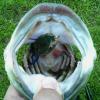I went bank fishing today on a local small lake (~30 acres). It's a shallow lake with a max depth of probably 10 ft or so out in the middle. The main cover is water willow on the banks and can get pretty thick in some spots where it extends out with points and in the backs of the two large pockets associated with the lake. There is very little rock in this lake. There is also some fish attractors that have been placed off shore in deeper water. Water temperature was 43 degrees so I expected i might get one to come up to a jerkbait off of a main lake point close to one of the fish attractors. I didn't get a bite and the water was a little dingy so I gave up on the jerkbait and started walking around the lake to see if I could see any fish.
When I came to the shallowest pocket of the lake. I seen about a three pound bass relating to a small patch of water willow in about a foot of water. I threw a few baits at her, but she didn't commit to anything. I walked a little deeper into the pocket and seen another good size bass up real shallow like the last, but soon found she wouldn't commit either. I wasn't too surprised I couldn't get one to bite. That lake has received a whole lot of pressure the last three months. I seen a good blow up as well in the same area. What was she blowing up on? I assume that baitfish wouldn't be hanging around in that cold shallow water. Either way, according to seasonal patterns, shouldn't the fish be out deep in the main lake with this cold water temperature? It has warmed up into the sixties the last few days but the water temp has only raised a few degrees.
Before anyone says, "The seasonal patterns are just guidelines." Yes, I know this, but why does it seem that the only time they follow those guidelines is in the spring time. Pre spawn, spawn, and post spawn are about the only times of the year when I can confidently go out and predict what a good bit of the bass are doing. I'm pretty good about predicting bass in the summer as well, but mid - late fall and winter can really get me flipped around. Also, it can be harder to catch bass in these time periods due to colder water temps making it of course even harder to learn more about bass habits this time of year.
Any thoughts?








